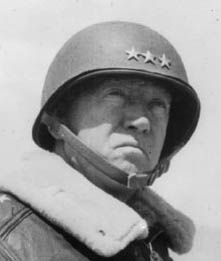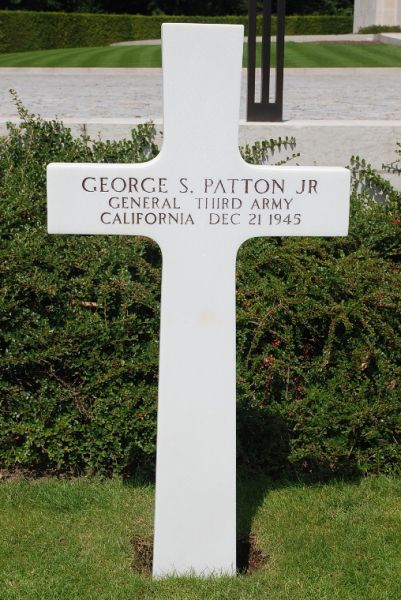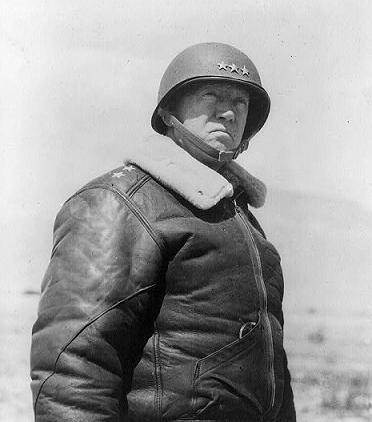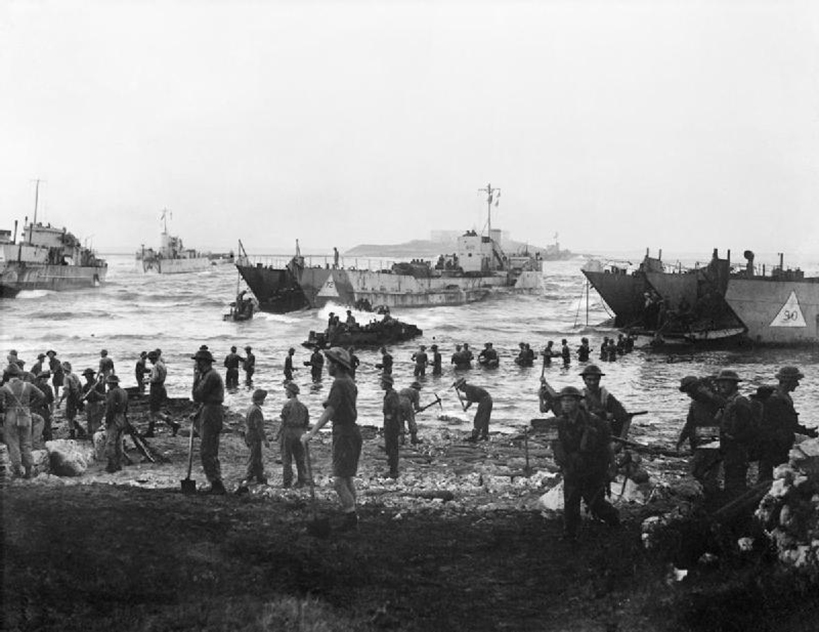Patton, George Smith Jr.
- Date of birth:
- November 11th, 1885 (San Gabriël/California, United States)
- Date of death:
- December 21st, 1945 (Heidelberg, Germany)
- Buried on:
- Luxembourg American Cemetery and Memorial
- Nationality:
- American
Biography
George Smith Patton jr. was born November 11th, 1885, in San Gabriël, California to a wealthy family. His interest in war was sparked by stories of his grandparents who had taken part in various wars. Patton was a gifted athlete during his years in school. In 1904, he enrolled in West Point Military Academy, graduating in 1909 in the rank of 2nd Lieutenant. He married Beatrice Ayer on May 26th, 1910. 1912 saw him participating in the Olympic Games in Stockholm, Sweden. In 1915 in Mexico, he got his first experience in battle. He was promoted to 1st. Lieutenant after having shot a general of the rebel's army with his Colt .45. Patton embarked for France when the United States got involved in WW 1. In France he was named deputy commander of an armoured corps and at the end of the war he had risen to the rank of Lieutenat-colonel. After having been injured several times and having fought frequently in the frontlines, he was promoted to the temporary rank of Colonel. After the war, this promotion was amended and he became a Major.
Patton wanted to develop the tank arm further after the war but permission was withheld. During the 20's he served in various staff functions. In 1935 he was promoted to Lieutenant-colonel definitely, in 1939 to Colonel and on October 1st, 1940, to Brigadeer-general and was transferred to Fort Benning, Georgia, where he was given command of 2 Tank Brigade and simultaneously promoted to Major-general.
The United States were drawn into WW 2 after the infamous Japanese attack on the US naval base at Pearl Harbor in the Pacific. Patton was to play a distinctive role in the conflict. November 8th, 1942, Patton was given command of Operation Torch, the Allied invasion of North-Africa. After this succesful operation, he was promoted to Lieutenant-general on March 12th, 1943 and put in command of 7th Army. From this point in time, Patton's career continues to be succesful but did not remain unblemished. From one of his speeches, 37 Italian POW's were executed in cold blood. General Omar N. Bradley initiated an investigation but broke it off prematurely to save Patton's skin. During the invasion of Sicily, Patton was compromised again for having slapped a soldier, suffering from shellshock in the face, believing him to be a coward. Patton even went so far as to issue a memo stating that 'those cowards should be court martialled'. Patton, under great pressure from his superior, General Dwight Eisenhower, offered his apologies but one week later, it happened again. This time, a furious Eisenhower relieved him of his command over 7th Army, replacing him by General Mark Clark. Patton was relegated to headquarters where he sat dragging his heels for almost a year until he was put in command of the US 3rd Army in 1944 on the eve of the Normandy invasion. Patton himself arrived in France, August 1st, 1944 and by December 13th, his troops had advanced as far as the Belgium-Luxemburg border. At that moment, Germany was preparing for her final convulsion, the Ardennes offensive. Partly due to Patton's committment, this offensive was repulsed and he even managed to drive the Germans back. After Patton's 3rd Army had linked up with 7th Army, both armies pushed on towards Germany and on March 22nd, 1945, his troops crossed the river Rhine near the village of Oppenheim. In April he was promoted to the rank of 4-star General.
At the end of WW 2, the American 3rd Army under George Patton had liberated or captured an area of some 100.000 square kilometres. September 1945, he was relieved of his command over 3rd Army for his sympathic attitude towards former Nazi's. His request to be transferred to the Pacific to fight the Japanese was rejected.
After the German surrender, he held the post of military governor of Bavaria for some time but he disliked the job. Although in the post-war years, several political functions had been offered to him, including that of Secretary of War, he accepted none of them.
December 9th, 1945, while still in Germany, Patton was involved in a serious car crash and broke his neck. He was taken to a military hospital in Heidelberg and there, General George S. Patton Jr. died from his injuries December 21st, 1945. His remains were buried in the American Military Cemetery of Hamm in Luxemburg.
Promotions:
1909: Cadet Adjutant;
1915: Lieutenant;
?: Captain;
?: Major;
?: Lieutenant Colonel;
?: temporary Colonel;
?: Colonel;
?: Brigadier General;
April 4th, 1941: Major General;
1943: Lieutenant General;
April 14th, 1945: General.
Do you have more information about this person? Inform us!
- Period:
- First World War (1914-1918)
- Rank:
- Lieutenant Colonel
- Unit:
- Tank Corps, American Expeditionary Forces (AEF), U.S. Army
- Awarded on:
- June 3rd, 1919
GHQ, American Expeditionary Forces, Citation Orders No. 4
[This award was rescinded under GHQ, American Expeditionary Forces, Citation Orders No. 8 (March 1, 1920) as the recipient has been awarded a Distinguished Service Cross for deed including this act.]
- Period:
- First World War (1914-1918)
- Rank:
- Colonel
- Unit:
- Tank Corps, American Expeditionary Forces (AEF), U.S. Army
- Awarded on:
- 1919
War Department, General Orders No. 133
- Period:
- First World War (1914-1918)
- Rank:
- Colonel
- Awarded on:
- 1919
War Department, General Orders No. 103
- Period:
- Second World War (1939-1945)
- Rank:
- Major General
- Awarded on:
- 1942
AF, General Orders No. 28
George S. Patton had already received a DSM during the First World War and received this second decoration as his first Oak Leaf Cluster to be worn on the ribbon of the first DSM.
- Period:
- Second World War (1939-1945)
- Rank:
- Lieutenant General
- Unit:
- Seventh Army, U.S. Army
- Awarded on:
- August 19th, 1943
Headquarters, U.S. Army-North African Theater of Operations, General Orders No. 80
George S. Patton had already received a DSC during the First World War and received this second decoration as his first Oak Leaf Cluster to be worn on the ribbon of the first DSC.
- Period:
- Second World War (1939-1945)
- Rank:
- Lieutenant General
- Awarded on:
- 1944
George S. Patton had already received a DSM during the First World War and received this third decoration as his first Oak Leaf Cluster to be worn on the ribbon of the first DSM.
- Period:
- Second World War (1939-1945)
- Rank:
- General
- Unit:
- Third Army, U.S. Army
- Awarded on:
- July 27th, 1945
- Period:
- Second World War (1939-1945)
- Rank:
- General
- Unit:
- Seventh Army, U.S. Army
- Awarded for:
- Operation Husky
- Period:
- Second World War (1939-1945)
- Period:
- Second World War (1939-1945)
- Rank:
- General
- Unit:
- I Armored Corps, U.S. Army
- Period:
- Second World War (1939-1945)
- Period:
- First World War (1914-1918)
- Rank:
- Lieutenant Colonel
- Unit:
- Tank Corps, American Expeditionary Forces (AEF), U.S. Army
- Period:
- Second World War (1939-1945)
- Period:
- Second World War (1939-1945)
- Period:
- Second World War (1939-1945)
- Period:
- Second World War (1939-1945)
- Period:
- Second World War (1939-1945)
- Period:
- First World War (1914-1918)
- Rank:
- Lieutenant Colonel
- Unit:
- Tank Corps, American Expeditionary Forces (AEF), U.S. Army
With bronze star
- Period:
- Second World War (1939-1945)
- Period:
- Second World War (1939-1945)
- Period:
- Second World War (1939-1945)
- Period:
- Second World War (1939-1945)
- Period:
- First World War (1914-1918)
- Period:
- Second World War (1939-1945)
- Period:
- Second World War (1939-1945)
- Period:
- Second World War (1939-1945)
- Period:
- Second World War (1939-1945)
War Diary mentions
15 November 1944 WO 171/838 - 4/7 Royal Dragoon Guards
The Brigade Comd (Brig G.E. Prior Palmer) visited Sqns in turn and gave the men an informal talk outlining the plans for the moment – 8 and 12 Corps offensive just started in VENLO sector, Americans under General Patton fighting for METZ, another big American push to start any day now south of 30 Corps sector, and 30 Corps with 84 US Div also u/c to start soon afterwards with our own show in GEILENKIRCHEN sector and then WALDENRATH (we making things nice and tidy for the Gds Armd Div to start!). He also spoke about the coming winter, warning us that it will be hard: leave was not on but all the Brigade would have had a go at the Bde Rest camp at LOUVAIN (near BRUSSELS) by 29 Nov 44.
Sources
- Photo 2: Find a Grave
- Photo: GNU Free Documentation License
- Find a Grave - - ROSMUS, A., Valhalla Finale, Büchet Pustet, Passau, Germany, 2009.
- Go2War2.nl
- pattonhq.com
- freeinfosociety.com
- generalpatton.org
- American Battle Monuments Commission
- The Military Times Hall of Valor
Photos
Background stories
The War Illustrated
- 07-'45: Eisenhower: the Man Behind the Name
- 07-'45: Now It Can Be Told! - Phantom Patrols: G.H.Q. Liaison Regiment

































